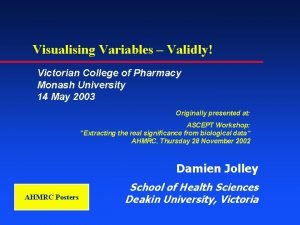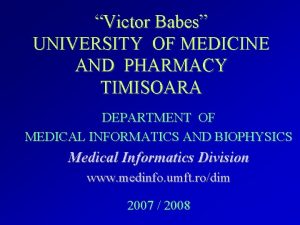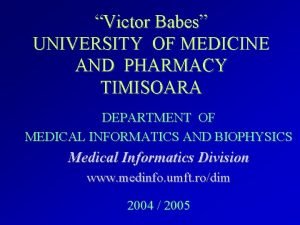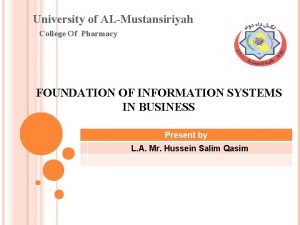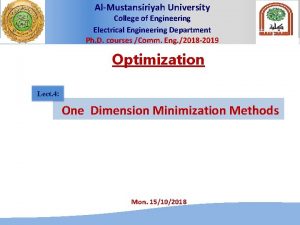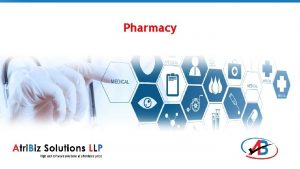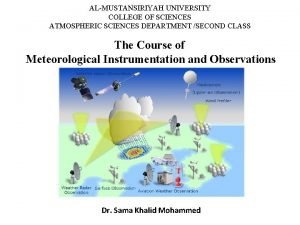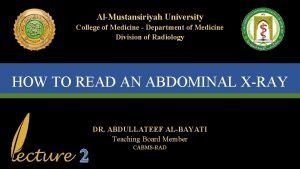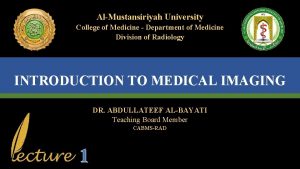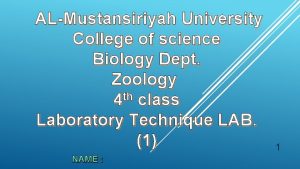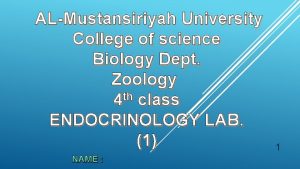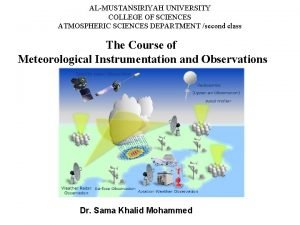University of ALMustansiriyah College Of Pharmacy CLASS 1












- Slides: 12

University of AL-Mustansiriyah College Of Pharmacy CLASS 1 FOUNDATION OF INFORMATION SYSTEMS IN BUSINESS Present by L. A. Mr. Hussein Salim Qasim 1

RESOURCES OF AN INFORMATION SYSTEM 2

RESOURCES OF AN INFORMATION SYSTEM 3

THE COMPONENTS OF AN INFORMATION SYSTEM Purpose — the reason for having the system People — includes the developers, managers, and users of the system Information Technology — the hardware, software, and network components Procedures (documentation and rules) — how people interact with the system Data — including text, images, sounds, and video 4

COMPUTER-BASED INFORMATION SYSTEMS Used following information technology: Computer hardware technologies, including microcomputers, midsize servers, Input, output, and storage devices. Computer software technologies, include operation system software, web browsers. Telecommunication network technology, include, the telecommunications media, processors, and software provide wireless access. Data resource management technologies, including database management system software for the development, access. 5

WHAT YOU NEED TO KNOW? Learn how to apply IS and technologies in unique business situation? What do you need to know in order to help manage the hardware, software, data and network resources of business, used for the strategic success of company. 6

THE FUNDAMENTAL ROLES OF IS IN BUSINESS The three vital roles of the business applications of IS: Support business processes and operation. Support business decision making by employee and managers, Support strategies for competitive advantage 7

COMPUTER SYSTEM CATEGORIES Mainframe Computers Midrange Computers Microcomputers 8

TRENDS IN COMPUTER SYSTEM CAPABILITIES First Generation Second Generation Third Generation Fourth Generation Fifth Generation Trend: Toward Smaller, Faster, More Reliable, and Less Costly Vacuum Tubes Solid-State Integrated Circuits LSI, VLSI Microprocessors Greater Power, Smaller Footprint Trend: Toward Easy to Purchase, and Easy to Maintain 9

MICROCOMPUTER SYSTEMS Handheld PDA, Computers Information Appliances Notebook Computers Desktop Computers Workstations Network Server Powerful microcomputer used in small LANs

NETWORK COMPUTERS AND TERMINALS Network Computer (Thin Client) Net. PC Network Terminal Benefits Lower purchase cost Easier maintenance Easier software distribution and licensing Computer platform standardization Reduced end user support requirements Improved manageability 11

COMPUTER SYSTEM COMPONENTS Central Processing Unit Input Devices Control Unit Special Purpose Processors ALU Cache Memory Secondary Storage Devices Output Devices Primary Storage 12
 King saud university college of pharmacy
King saud university college of pharmacy King saud university college of pharmacy
King saud university college of pharmacy King saud university college of pharmacy
King saud university college of pharmacy 沈榮麟
沈榮麟 Victorian college of pharmacy
Victorian college of pharmacy Um college of pharmacy
Um college of pharmacy Babesuniversity
Babesuniversity Victor babeş university of medicine and pharmacy
Victor babeş university of medicine and pharmacy Victor babes university
Victor babes university Au pharmaceutical care center
Au pharmaceutical care center Asd college college readiness program
Asd college college readiness program Early college high school at midland college
Early college high school at midland college Types of tourists
Types of tourists




